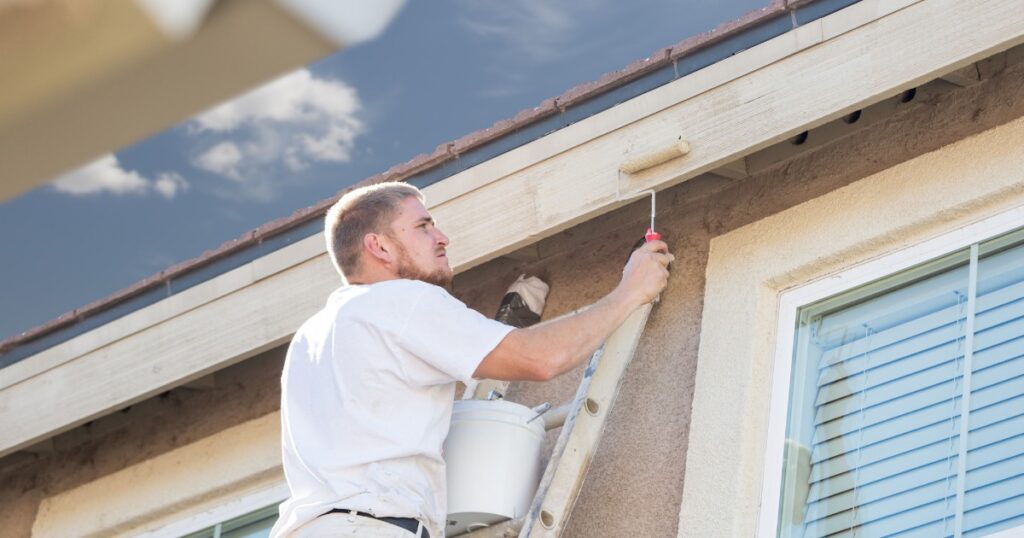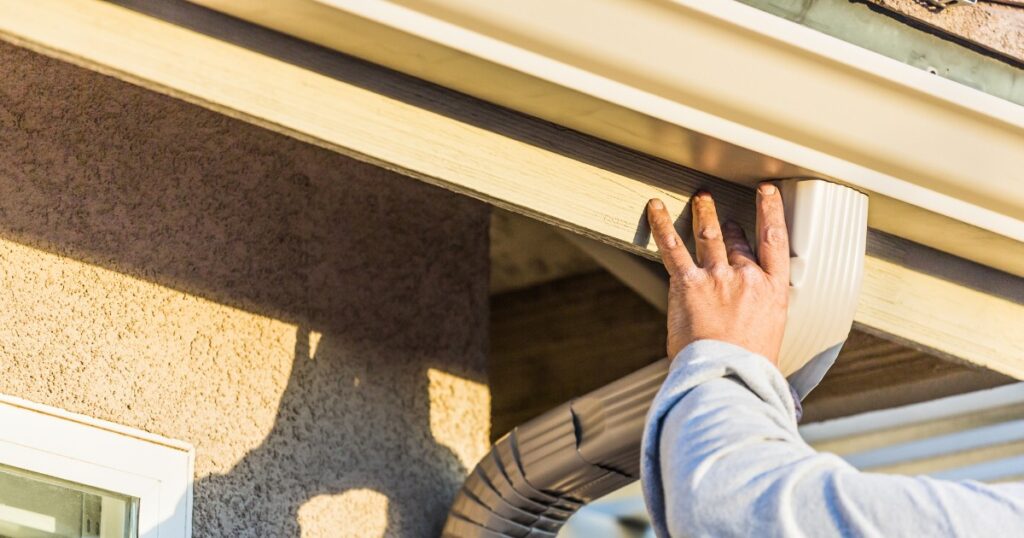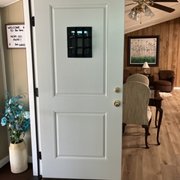Fascia is an architectural element found in houses for functional and aesthetic purposes. Simply put, fascia is the long, horizontal band beneath the roof’s edge, typically where the gutters are attached. Protecting a home’s exterior and enhancing its overall appearance is essential.
The significance of fascia in houses cannot be overstated. It acts as a protective barrier against various elements of nature, including rain, snow, and debris. By covering the exposed ends of the roof rafters, fascia prevents water from seeping into the underlying structure, averting potential damage and rot. This is particularly important in regions with heavy rainfall or harsh weather conditions.
What is Fascia?
Fascia, a term commonly used in the construction industry, refers to the long, horizontal band situated beneath the edge of a house’s roof. The fascia serves as a protective and decorative element. Its primary purpose is to shield the house’s exterior from the elements and enhance its overall visual appeal.
Fascia can be found along the roofline, which acts as a barrier against nature’s forces. Positioned below the roof edge, it prevents rainwater, snow, and debris from infiltrating the underlying structure. This shields the house from potential damage and rot, particularly in regions with inclement weather conditions.
Homeowners can choose from various fascia materials, allowing them to match their homes’ architectural styles and personal preferences. This selection process is important in enhancing the overall curb appeal, making the house more visually appealing and attractive.
Fascia plays a role in maintaining the structural integrity of a house. Acting as a support for the lower row of roof tiles or shingles, it provides stability and prevents them from sagging or becoming loose over time.
Functions of Fascia on Houses
Fascia acts as a sturdy shield, safeguarding the house against the relentless forces of nature. Rain, snow, and debris are effectively prevented from infiltrating the underlying structure, thus averting potential damage and decay. Fascia is a protective barrier that keeps water and other harmful elements at bay.
In addition to its protective function, fascia contributes to the house’s structural integrity. It is a reliable support system for the lower row of roof tiles or shingles, ensuring stability and preventing sagging or loosening. This structural reinforcement minimizes the risk of roof damage caused by strong winds or heavy rainfall, thus preserving the overall strength of the house.
Fascia is also great for enhancing a house’s aesthetic appeal. It serves as a finishing touch that adds a touch of elegance and cohesion to the roofline. There is a wide variety of materials, colors, and styles available. Homeowners can customize their fascia and create a visually pleasing appearance that complements the overall design of their homes.
Materials Used for Fascia
When constructing fascia, there are several common materials, each with advantages and disadvantages.
- One popular material for fascia construction is wood. Wood fascia exudes a timeless charm and natural beauty that complements various architectural styles. It can be easily customized and painted to match the house’s color scheme. However, wood requires regular maintenance to prevent rot, warping, and insect infestation.
- Aluminum fascia is lightweight, durable, and resistant to deterioration and corrosion. It protects against the elements and requires minimal maintenance. However, it may dent or scratch more quickly than other materials, and its appearance may not suit every architectural style.
- Vinyl is also a popular choice for fascia construction. It is affordable, low-maintenance, and resistant to rot, insects, and warping. Vinyl fascia comes in various colors and styles, making it versatile and easy to match with different house designs. However, extreme temperatures can cause vinyl to expand or contract, potentially affecting its durability.
- Composites, such as PVC or fiber cement, offer the look of wood while providing increased durability, moisture resistance, and low maintenance. They are less susceptible to rot, insects, and warping. However, composite fascia tends to be more expensive than other materials.
Installation and Maintenance of Fascia

When it comes to installation, proper technique is essential. It starts with accurate measurements and precise cutting of the fascia materials to ensure a seamless fit. Secure attachment to the roof edge using appropriate fasteners for stability and resistance to weather conditions. Following manufacturer guidelines and consulting professionals can help ensure a successful installation.
Maintenance practices play a role in prolonging the lifespan of fascia. Regular inspections should be conducted. It is a way to identify any signs of damage, such as cracks, rot, or loose sections. Prompt repairs or replacements should be carried out to prevent further deterioration. Cleaning the fascia periodically, particularly in areas prone to debris buildup, helps maintain its appearance and functionality.
Common Issues and Repairs
Common problems with the fascia on houses include rot, water damage, insect infestation, warping, and cracks. These issues can result from exposure to moisture, prolonged sun exposure, poor installation, or neglected maintenance. Signs of trouble include discoloration, soft spots, sagging, or visible damage.
Steps for Repairing Damaged or Deteriorated Fascia
- The damaged section of the fascia needs to be accurately identified and marked.
- Any repairs to the underlying structure, such as fixing rotten or damaged rafters, should be addressed.
- It involves removing the damaged fascia. This can be done by carefully prying it away from the fasteners, taking care not to cause further damage.
- Once the damaged fascia is removed, the area should be thoroughly cleaned and prepared to install the new fascia.
- The replacement fascia should be cut to the correct measurements and securely attached using appropriate fasteners.
- Ensuring a proper fit and alignment with the existing fascia is essential to maintaining a seamless appearance.
- If necessary, the new fascia can be painted or finished to match the rest of the house’s exterior.
Fascia Styles and Design Options
When it comes to fascia, a wide array of styles and profiles are available. Some popular types include flat fascia, ogee fascia, crown molding fascia, and square-edge fascia. Each class presents a unique aesthetic, allowing homeowners to choose one that best suits their taste and the architectural style of their house.
Flat fascia offers a clean and minimalist look, ideal for modern and contemporary designs. With its decorative curves and intricate detailing,
Ogee fascia adds a touch of elegance and sophistication, making it suitable for traditional or Victorian-style houses.
Crown molding fascia brings a sense of grandeur and refinement.
Square-edge fascia offers a simple and streamlined appearance.
In addition to various styles, fascia design options include the choice of materials, colors, and finishes. Wood fascia provides a warm and natural look, while aluminum fascia offers a sleek and modern aesthetic. Vinyl fascia comes in various colors, allowing homeowners to match it with their house’s exterior palette. Some materials can even mimic the look of wood grain or other textures, providing versatility and customization options.
When selecting the right fascia design for your house, consider the home’s overall architectural style and character. Harmonizing the fascia with other exterior elements, such as siding, windows, and trim, creates a cohesive and visually appealing look. Considering the house’s color scheme and the surrounding environment can also influence the choice of fascia design.
Fascia and Gutter Systems

The connection between fascia and gutter installation is something else to look at. Fascia is the gutter system’s anchor, providing a stable and secure attachment point. The gutter system may not function effectively without an adequately installed fascia and may become unstable or detached over time.
Integrating fascia and gutter systems ensures seamless functionality and optimal water drainage. The fascia acts as a support for the gutters, ensuring they are securely fastened and properly aligned. This alignment is essential for directing rainwater and debris away from the roof and foundation of the house, preventing potential water damage.
During installation, we carefully prepare the fascia to accommodate the gutter system. Proper measurements and alignment ensure a tight fit and efficient water flow. When positioning the gutter system along the fascia, expert installers consider roof pitch, water volume, and potential debris buildup.
Regular maintenance and inspections of the fascia and gutter system are necessary to ensure their continued functionality. Cleaning gutters and removing debris prevents clogging and ensures proper water flow. Inspecting the fascia for signs of damage, such as rot or deterioration, allows for timely repairs or replacements.
Fascia Replacement and Upgrades
Various signs indicate the need for fascia replacement. These include rot, decay, visible cracks, warping, discoloration, or pest infestation. If the fascia deteriorates beyond repair or compromises the house’s structural integrity, replacement becomes necessary to prevent further damage and maintain the overall stability of the property.
Moreover, homeowners may upgrade the fascia on the house for improved performance and aesthetics. Upgrading the fascia allows one to select modern materials with enhanced durability, weather resistance, and low maintenance. Materials such as composite or PVC fascia can offer superior longevity and resistance to moisture, insects, and warping compared to the traditional wood fascia.
When considering fascia replacement or upgrades, homeowners should consult professionals to assess the condition of the existing fascia and provide expert guidance on suitable replacement materials and design options. To ensure a seamless and secure fit, maximizing the performance and longevity of the new fascia, you should follow proper installation techniques.
Importance of Fascia in Houses
Recapping the importance of fascia on house, it is a protective barrier against weather elements, safeguarding the underlying structure from moisture damage, rot, and decay. It also provides structural support and stability, ensuring the integrity of the roof edge and the overall strength of the house. Additionally, fascia adds to the aesthetic appeal of a home, serving as a finishing touch that enhances the exterior appearance.
Maintaining and enhancing the functionality of fascia is important. Regular inspections, timely repairs, and proactive maintenance are essential to address any issues promptly and prevent further damage. Considering upgrades and design options can significantly enhance the performance and visual appeal of the fascia, ultimately contributing to the overall beauty and value of the house.



























